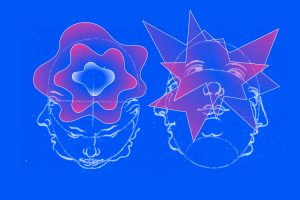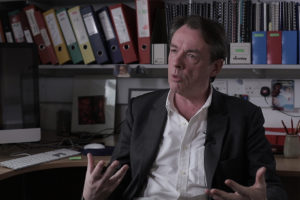Migraine
Neurologist Richard Lipton on zigzag visions, baby alligators, and devices that can help to treat migraine
My field of expertise is concerning the psychology of music and the neuroscience of music. This is an area that has become rather popular over the last 10-20 years or so. The reason that I started doing research in this field is because I was working at the Institute of Cognitive Neuroscience for Professor Uta Frith, who was very interested in how the brain changes as we acquire literacy. We realized that thinking about musical literacy could give us a way to understand how a form of notation can change the brain.
So I actually started off my research career by looking at how becoming able to read music and play the piano changes people’s brain activity. To do this, I did a longitudinal study taking people who had no idea of how to read music or play the piano, and over three months, I taught them and looked at how the brain responded differently to musical notes before and after training. I never thought of myself as really studying music and the brain, but it doesn’t matter how you think of yourself; it matters how other people perceive you.

Following this work, I was offered a position as a postdoc with Timothy Griffiths, and we started looking at more auditory perceptual aspects of musical experience. In particular, we started looking at something called congenital amusia: this is a disorder that can be considered to be a literal kind of tone deafness. Many people say that they are tone deaf, and mostly, they mean that they feel that they can’t hold a tune very well and that they’re a little bit out of tune when they’re singing. But congenital amusia is rather different. It refers to an actual genuine perceptual problem where, for instance, people might not perceive very culturally typical songs to be familiar, so ‘Happy Birthday’ or the national anthem wouldn’t be recognized, and if you hear two tunes to someone with congenital amusia they may sound like the same tune.
So Tim Griffiths and I were very interested in recruiting a sample of people who have this disorder, and we used Isabelle Peretz’s battery, which is called The Montreal Battery of Evaluation of Amusia. It’s really a battery of tasks where you listen to pairs of tunes, and you say whether they’re the same or different. Having used this battery on several hundreds of thousands of people that we recruited via the BBC website, we were able to then invite people who scored at the bottom end of the range into the lab, and we did a number of different investigations to work out what seemed to be going wrong in these cases of congenital amusia.
We were asking questions like what is the fundamental processing difficulty in congenital amusia. Is it a problem, for instance, in hearing a pitch change or discriminating the direction of a pitch change? Is it a problem with pitch memory? Does it extend to problems with information in speech? Can people with congenital amusia appreciate music? Are there timbre difficulties as well?
So we pursued this disorder on a number of different fronts, and we’ve published quite widely on that. Some of that research is available for people who want to know a little bit more: that’s probably all I’ll say about that project, which spanned a few years.
My next grant was really looking at something a little bit different: from people who have too little music going on in their heads to people who have quite a lot of music, so people who have earworms or tunes in their heads. This was work funded by the Leverhulme Trust, and we were really interested in trying to understand why people have music in their heads and what determines differences among people so that some people hardly ever have tunes going around in their heads and other people seem to report that they have a continual musical experience that stems from within themselves.
I got in touch with the program and asked them if they would be interested in sharing some of these anonymized reports with us. From this, we were able to come up with a list of tunes that were commonly reported as being experienced as earworms. We were really interested to say, well, what do these tunes have in common? Have they got some structural features in common that might explain why they are more likely than other tunes to come to mind as earworms?
So, for each of these commonly reported tunes, we found a control tune that was similar in terms of its chart success, its genre, and sometimes even the same artists but was never reported as an earworm. Then we had these two lists: the list had never been reported as earworms in our sample anyway, and the list was often reported as earworms. Then, we were able to use some techniques that my colleague Daniel Mullensiefen developed to ask what it is that characterizes this particularly “earwormy” tune.
That was a piece of research we did, and a bit simplified answer is that it’s a combination between features of a songs that are very expected but also a couple that are a little bit unusual. One thing that’s unusual and causes a tune to be more likely to appear as an earworm is if it has an unusual contour pattern, so the pitch interval is a bit unusual, for instance.
Again, we’ve published on this, and there are lots of details in the relevant publication.
We also looked to see whether or not differences in brain structure could explain why some people would get earworms more frequently than others. Again, we found some differences in the auditory and frontal parts of the brain, suggesting that perhaps cortical structure can determine whether you’re more likely to have an earworm. This may be to do with things like this strength of connection between the auditory cortex and the frontal parts of the brain, which we know are important in pitch memory and rehearsal processes.
One study that we never got around to doing that I’m always very interested to know the answer to is whether or not we can understand the functional importance of earworms. For instance, I had the idea that perhaps generating one’s own inner music could have an important role in regulating our state of arousal. Sometimes, you’re in a situation where you need to be in a high state of alertness to deal with the situation that you find yourself in, but actually, you’re feeling in a different state. Could it be, for instance, that generating this inner music, particularly, if you like, selecting tunes that are particularly up-tempo if you need to increase your arousal could, could this be a way of essentially modulating your own state of arousal such that you’re optimally ready to deal with the task at hand?
So just in the same way that we deliberately and strategically listen to actual music as a way of either matching or changing our mood and our arousal, it may be that this inner music and our earworms may be fulfilling a similar sort of function in terms of our state of mood and arousal.
But it’s a little bit of a difficult question to test, and it’s something we may get around to in the future if we can.
Some of my current projects are really addressing questions about whether or not music can be used in particular situations of health management. I’ve recently been awarded a grant from the Medical Research Council and the Arts and Humanities Research Council. That’s a very interdisciplinary project; it involves collaboration with my colleague Bonnie McConnell, who’s an ethnomusicologist; Paul Ramchandani, who’s a perinatal psychiatrist; Vivette Glover, who’s a biochemist, also with my PhD student Katie Rose Sanfilippo. What we’re doing is exploring in a particular region in Africa, in the Gambia in West Africa, whether or not traditional musical practices can be used to support women’s mental health during pregnancy. This is a particularly important area because we know that anxiety and depression during pregnancy can (doesn’t always but can) have biological consequences for the development of the fetus because of direct pathways in utero between the mother and the developing fetus. So, although we’re used to paying attention to physical health during pregnancy, it’s less usual to ask about a woman’s maternal mental health.
Finally, I’ll just say a few words. We’re collaborating with the National Hospital for Neurology and Neurosurgery, specifically their upper limb service for patients who’ve had a stroke. We are interested in how we can design interfaces using digital music to really motivate stroke patients to engage with their rehabilitation. We know that rehab is something that once patients are discharged home, they don’t really engage with: it’s very difficult, it’s quite boring. We can make use of some of the properties of music, self-chosen favourite music that can be very rhythmic and entraining. These are very useful properties to get patients to really engage with the repetitions that are required to promote motor relearning after stroke.
I’ve covered a lot of ground there, but this is a very interesting area, I think, not only to think about how music is processed in the brain but actually how we can use that knowledge to design approaches to support people’s mental health and also physical health.

Neurologist Richard Lipton on zigzag visions, baby alligators, and devices that can help to treat migraine

Biogerontologist David Gems on the innate plasticity in aging, senolytic drugs and whether we should expect dr...

Social neuroscientist Antonia Hamilton on social connotations of imitation, copying silly actions, and mockery